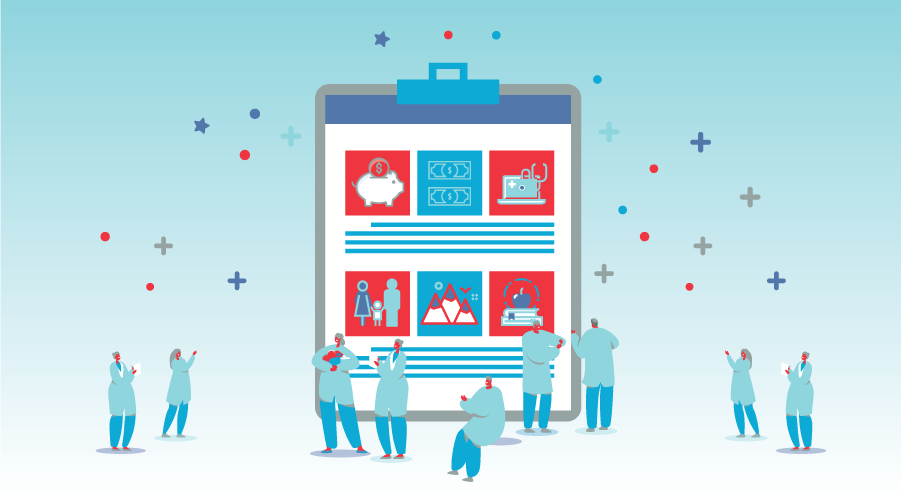Health insurance. Paid leave. Retirement plans. For most independent community pharmacies, there is likely no legal obligation to provide these benefits or others to your employees. They can be costly, and with profit margins already thin, why should you bother with an expensive benefits package?
“The crux of it is that talent is hard to come by,” said Grace Jaén, vice president of health and welfare at G&A Partners, a professional employer organization that assists small businesses with tasks like human resources, benefits, workers compensation, and payroll. “Ultimately the only reason that you have to offer benefits is to recruit and retain employees.”
“When a company provides benefits such as health insurance or tuition reimbursement or other voluntary benefits, generally, it helps in attracting employees and it also reduces turnover,” said John Dooney, a knowledge advisor for the Society for Human Resources Management. “That’s really one of the best arguments for providing them, and it shows that the company cares about the health of their employees.”
Think of employee benefits as an integral part of your compensation plan rather than a series of optional extras. “Your benefits package is where you can strategically differentiate your compensation from the competition,” said Tae Youn Park, associate professor of human resources studies at Cornell University’s ILR school.
According to the Bureau of Labor Statistics, employers spend around 30 percent of their total compensation package on benefits, meaning for every $100 you spend on compensation, $70 goes to wages and $30 goes to benefits. “Communicating about that 30 percent is really critical,” said Park. “Employees tend to not think about the 30 percent, but it can be very useful in signaling that it’s better to work for you than it is at some other location.”
This comprehensive guide to employee benefits will help you tap into the perks employees want the most so you can retain your best team members and win over top talent.
Health Insurance
If your pharmacy has fewer than 50 full-time employees, there’s no legal obligation to provide health insurance. But to remain competitive as an employer, it’s a good idea to provide it anyway. “People tend to think of benefits like health insurance as a legal requirement, even though that’s not the case,” Park said. “They just have expectations that businesses are going to provide it.”
Health insurance can be costly for an employer—the Kaiser Family Foundation found the average annual cost to employers was $6,440 per employee in 2021—so use a broker to shop around. “Carriers will have different requirements, but typically the employer is going to pay for at least 50 percent of the medical premium on base plan,” said Jaén. “That’s the lowest. It’s more standard that we see an employer pay 75 percent of a base-level plan and use that same dollar amount to apply to other higher-tier plans.”
When choosing a health insurance plan for your employees, Jaén recommends performing a benchmark study of similar markets to find out what they are doing to ensure your package is comparable or better. To keep your health insurance plan, you may want to offer a menu of plans with a range of deductibles, premiums, and care options.
Preferred provider organization (PPO) plans have a large network of doctors, hospitals, and specialists. These come with a range of premium and deductible options.
Health maintenance organization (HMO) plans have a smaller network of providers, and employees must be referred to see a specialist. These come with lower premiums and deductibles.
“Employees should ensure that the plan they choose allows a spouse to be added to it,” Dooney said. The ACA requires dependent eligibility, but not spouses, and having that option will create an added value for employees.
Also consider add-ons like dental and vision insurance, short-term disability, or an employee assistance program. “This kind of ancillary package is something that the employer doesn’t have to spend any money on, but it gives employees the option to get plans that they may not otherwise have access to, sometimes at a discounted rate,” said Jaén.
FSA OR HSA?
Flexible spending accounts (FSAs) and health savings accounts (HSAs) both allow employees to save for qualified health expenses before taxes. Consider the features of each when choosing a health insurance plan for your employees.
Health savings accounts
- Become available with high deductible health plans
- Are owned by the employee, and they can take the savings when they leave their job
- Savings carry over from year to year and never expire
- Can be used as long-term or retirement savings
- Cannot be used for dependent care
- Have a maximum contribution limit of $3,650 for individuals and $7,300 for families
Flexible spending accounts
- Become available with a traditional employer-provided health plan
- Are owned by the employer, and savings must be forfeited when employees resign
- A maximum of $570 can be carried over each year, depending on the plan
- Cannot be used as long-term or retirement savings
- Can be used for dependent care
- Have a maximum contribution limit of $2,850 for qualified health expenses and $5,000 for dependent care expenses
Retirement Benefits
Retirement options typically fall into two categories: a defined benefit plan or a defined contribution plan.
A defined benefit plan is what many think of as a traditional pension plan in which the employer funds a promised amount for retirement. “There aren’t many of these plans anymore. They used to be more popular, but maybe 5 percent of organizations outside the government offer them,” said Dooney.
A 401(k) falls under the defined contribution plan category, which means that employees make contributions to fund their own retirement. “This shifts investment risks from the business to the employees. The stock market has been performing fairly well in the past decades, so employees have been getting more returns from the defined contribution plan than the defined benefit plan,” Park said.
While there are other options for retirement plans, a 401(k) is by far the most popular because it allows employees to make contributions before taxes. If you decide to offer a 401(k), the next decision is whether you will match contributions, and if so, how much.
When employers offer a match, they allow employees to essentially double their retirement investment. For job-seekers who are thinking about long-term financial stability, an employer that offers a 5 percent match will be more appealing than one that offers a 2 percent match.
“Only about half of employers who have a 401(k) plan in place offer any sort of match,” said Jaén. For employers that do offer to match contributions, the average is around 3.5 percent.
When offering a match, be sure to budget for the highest potential costs, Jaén said. Assume that 100 percent of your employees will enroll and max out their potential matching contribution. “It’s very hard to give an employee a benefit and then scale it back later if you find you can’t afford it,” she said. “If you’re just getting started with 401(k) matching, start where you can really feel comfortable. You can always increase the benefit later, but it’s so hard to take it away.”
401(k) tax benefits
A 401(k) isn’t just a good recruiting tool—employers can also use their 401(k) plan to reap additional benefits come tax season.
Startup cost tax credit
The SECURE Act rewards small businesses that set up an employee 401(k) plan by creating a tax credit for qualified startup costs. The credit is whichever is greater: $500 or the lesser of $5,000 or $250 multiplied by the number of non-highly compensated employees. Businesses can claim this credit for up to three years.
Auto contribution tax credit
Employers can claim another $500 in tax credits for three years by automatically enrolling eligible employees in the 401(k) plan.
Matching contribution deduction
If employers opt to match contributions to employee 401(k)s, those contributions can be considered business expenses and treated as tax-deductible.
1000-hour eligibility
While there is no requirement for your pharmacy to offer a 401(k) plan to employees, if you do, you must adhere to a regulation that requires all employees who work at least 1,000 hours in a 12-month period to be eligible for enrollment.
In 2024, provisions of the SECURE Act will expand eligibility even further. The SECURE Act requires that long-term part-time employees also be allowed to enroll in a 401(k) plan. This applies to non-union employees who have worked between 500 and 999 hours in the previous 3 consecutive years.
Paid Leave
While not a legal requirement in most states, offering some sort of paid leave is necessary to win over employees. “It’s more a matter of how many days you will offer than whether to offer them, in my opinion,” Park said.
Paid leave falls into two categories, combined paid time off (PTO) that includes both sick and personal leave or separate vacation and sick leave buckets. “Generally, if it’s PTO with combined sick and other leave, the employer will have to pay out when an employee leaves, so when that occurs, an employer could be paying out more with PTO versus just vacation leave,” Dooney said.
“If you’re just getting your toes in the water with paid leave, we recommend starting out with 80 hours of combined PTO for new employees,” Jaén said. Typically, the amount of paid leave an employee has will increase with their tenure at the company.
According to the Bureau of Labor Statistics (BLS), employees with a one-year tenure tend to have between 5 and 14 vacation days, while those with a 20-year tenure will have 20 or more. On average, workers of all tenure have 7 sick days.
“Younger generations are paying a lot more attention to mental and physical health issues,” Park said. “In that case, offering enough paid time off is a very effective way for them to take care of that.”
Most workers who receive paid leave are full-time employees, but part-timers will also get sick or need the occasional day off. Offering some form of paid leave to part-time employees will discourage them from coming in when they are sick, which is especially important in a healthcare setting.
Paid leave is also a good tool to keep your best employees content during a labor shortage. “When you’re dealing with skilled labor, you are trying to keep them from leaving with their hard-to-replace skills, so you may be better off having generous benefits in place,” Dooney said.
Parental leave
Parental leave as an employee benefit was once uncommon, but employees are now more eager for it.
“It’s becoming a more popular benefit than we have seen historically,” Jaén said. “Some companies put it as part of their PTO package, or they can offer it separately.”
It’s important to note that parental leave is different from FMLA leave, which is often used by new parents who want to take unpaid leave for the birth and care of their newborn child.
There is also a distinction between maternity leave and parental leave. Maternity leave is time for mothers to recover from childbirth. Often, maternity leave policies will specify a leave time of 6 weeks to recover from a normal vaginal delivery and 8 weeks to recover from a c-section.
Parental leave, however, is gender-neutral, and it is intended to provide new parents time to bond with their child. “If you’re going to offer parental leave, you need to offer the same amount for both the mother and the father,” Jaén said.
When building a parental leave policy, you’ll also have to decide whether you want to offer it as a paid leave or an unpaid leave. “We see that about 40 percent of companies offer some sort of paid leave for new parents, but it’s at all different levels,” said Dooney.
If you offer short-term disability insurance for your employees, new mothers can use that benefit to keep getting paid a portion of their wages while they aren’t working.
Compensation
In a job-seekers market, a competitive wage is the most effective way to win over the best talent.
“People come to work for wages,” Jaén said. “Medical benefits are a factor, too, but wages are really the major consideration for why an employee would think about moving to a new job.”
She said that G&A Partners helps clients determine appropriate wages by creating a job description and performing a benchmark study based on the described duties. Pharmacies that don’t have the resources to do a full benchmark study can use resources like the Bureau of Labor Statistics, Glassdoor, and even Google, to determine what wages are appropriate.
As we come out of the recession caused by the Covid-19 pandemic, keep the changing job market in mind. With many employees moving to new jobs and higher than usual inflation, wage expectations are being pushed upward.
“It costs more to bring people on to perform a job right now, so the existing employees will have comparatively lower compensation in comparison,” Dooney pointed out. Employers should perform salary reviews in order to ensure that long-term employees are not getting left behind. If you don’t adjust salaries, you encourage employees to leave and get a higher salary elsewhere.
“We’re seeing a lot of amazing employees getting recruited by other companies right now,” Jaén said. Sometimes they go back to their current employer and give them a chance to make a counter-offer, but sometimes they don’t, so it’s important to proactively pay your mission-critical employees a high wage.
Exempt vs. non-exempt
Non-exempt employees
Certain employees are entitled to protections under the Fair Labor Standards Act. Classified as non-exempt, these employees are entitled to earn the minimum wage, and they must receive overtime pay when they work over 40 hours a week. Non-exempt employees are typically paid on an hourly basis, or they have a salary that is less than $35,568 a year.
Exempt employees
Exempt employees, on the other hand, are not required to receive overtime pay (although employers can compensate exempt employees for extra work if they wish). They also typically earn a salary instead of hourly pay.
To be classified as exempt, the employee must pass the Department of Labor’s duties test, which determines whether they qualify for one of the following exemptions:
- Administrative exemption
- Executive exemption
- Learned professional exemption
- Creative professional exemption
- Outside sales exemption
Base pay vs variable pay
There are two ways to think about compensation.
The most common way employees are compensated is through a flat payment. This could be an hourly wage or a yearly salary, but employees know exactly what compensation they will get for the work they put in.
But you can also reward your employees by implementing a profit-sharing agreement on top of that base payment. “Under this model, you share the annual profit. You tell the employees about how the business is going and how much you earned that year, and then you tell them how much of that you are going to share with them,” Park explained.
A profit-sharing plan will make your employees more invested in the success of the pharmacy, and the promise of extra income at the end of the year can differentiate you from competitors who are only offering that base rate.
Tuition Assistance
Tuition support is a way to invest in individual employees while also investing in the future of the business.
“Offering tuition support will help you attract the type of employees who want to continue their education while working,” Park said.
When designing a tuition assistance program, be clear about the conditions attached and what kind of programs are eligible. You can reap a long-term benefit by providing assistance to employees who want to become pharmacists or pharmacy techs, but there’s less of a benefit in assisting an employee with their modern dance degree.
In addition to narrowing down the programs that are eligible for assistance, you can also place conditions on things like which schools employees can attend or what GPA they must maintain.
You can even exclude up to $5,250 per employee from taxable income when you provide tuition assistance at the graduate or undergraduate level.
Pet Insurance
Don’t just think about your employees when building a benefits package—show them you care about their furry friends, too.
“During Covid, many people adopted pets, and so pet insurance is the new benefit that seems to be of interest to employees,” said Dooney.
A comprehensive pet insurance policy works similarly to a human health insurance policy. It will cover vet bills, ranging from annual wellness visits to chronic conditions to acute illnesses.
Because veterinary bills have the potential to be extremely costly, a pet insurance policy can be an incredibly valuable benefit for current employees and job candidates who have pets.
Telemed Assist
The hot topic in the past five years, but especially in the last year, is telehealth,” said Jaén.
These services are available to your employees 24/7. They can talk to a healthcare professional who can write them prescriptions or connect them to the care they need.
“It’s dirt cheap and the reception by employees is hugely positive,” Jaén said. “The perceived value of the benefit is astronomical compared to the actual cost to the employer.”
Telehealth plans may be available as an add-on to your standard health insurance, but Jaén pointed out that when it comes as a bundled service, employees typically have to pay a co-pay, which makes it less popular. With a standalone plan, there will be no charge to employees.
From the Magazine
This article was published in our quarterly print magazine, which covers relevant topics in greater depth featuring leading experts in the industry. Subscribe to receive the quarterly print issue in your mailbox. All registered independent pharmacies in the U.S. are eligible to receive a free subscription.
More articles from the March 2022 issue:
- Employee Benefits: The Complete Guide for Independent Pharmacies
- This Compounded Drug Has a 50% Profit Margin and Is Changing Lives
- Inspired End Cap Tips From a National Retail Consultant
- Over-the-Counter Hearing Aids: Everything Pharmacies Need to Know
- 8 Pharmacy Services Third Parties Will Pay For
- How to Streamline Workers’ Compensation Claims
- Chronic Care Management Offers High Reimbursement for Low Investment
A Member-Owned Company Serving Independent Pharmacies
PBA Health is dedicated to helping independent pharmacies reach their full potential on the buy-side of their business. Founded and run by pharmacists, PBA Health serves independent pharmacies with group purchasing services, wholesaler contract negotiations, proprietary purchasing tools, and more.
An HDA member, PBA Health operates its own NABP-accredited warehouse with more than 6,000 SKUs, including brands, generics, narcotics CII-CV, cold-storage products, and over-the-counter (OTC) products — offering the lowest prices in the secondary market.
















